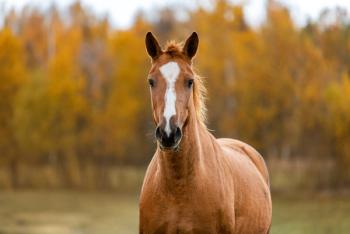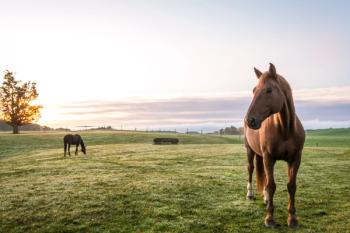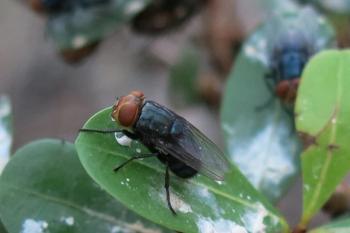
Olympics: A wet start for DVMs, equestrians
Veterinarians talk about the Beijing Olympic Games in DVM Newsmagazine interview.
Hong Kong
- Perhaps the one constant so far for the U.S. equestrian team and the veterinarians accompanying them at the Summer Olympics is the weather.
Photo by Mark Dadswell/Getty Images
Karen O'Connor of the U.S. equestrian team rides Mandiba as the horse clears a jump during the eventing cross-country competition Monday at the Olympic Equestrian Venue at Beas River Country Club near Hong Kong.
It's been "very wet so far," Dr. Sharon Spier, a professor at the University of California-Davis School of Veterinary Medicine, writes in an e-mail from the core equestrian venue at Sha Tin.
Last week, before the official start of the games, the equestrians and veterinarians had to wait out a typhoon, and it's been raining a lot ever since, but that didn't halt or delay any of the preliminaries or the official start of competition on Saturday, Aug. 9.
Air quality and the August heat in Hong Kong were major concerns for the competitors and their veterinarians as they prepared for the games. The rains could ease those concerns to some extent.
On opening day, "We were having what Hong Kong natives call light rain. We would call it a downpour," Catherine W. Kohn, VMD, Dipl. ACVIM, a professor in the Department of Veterinary Clinical Sciences at The Ohio State University, tells DVM Newsmagazine in her second e-mail update.
Spier and her husband, Dr. Jack Snyder, who also teaches at the UC-Davis veterinary school, coordinate medical and surgical aspects of the veterinary facility at the games. They have served at the summer games since the 1988 Olympics in Seoul, South Korea.
They and Kohn are among 30 international "staff" veterinarians who advise "team" veterinarians accompanying the 280 horses. Snyder is in charge of surgical procedures and Spier, an internal-medicine specialist, handles any infections or internal diseases or disorders. "Have been working with various horses with fevers and colic and mild dehydration, but all is well," Spier writes.
Kohn's latest e-mail describes the long and busy opening-day activities for veterinarians, culminating in the equestrians' own colorful "opening ceremony" Friday evening.
"We had a very early start (up at 3:30), with a bus ride at 4:15 a.m. to the cross-country venue at the Beas River Country Club, for a rehearsal of procedures for the cross-country test on Monday (Aug. 11).
"We got very wet as we walked to the veterinary clinic from the security checkpoint, past the two floor stables, with horses looking at us over Dutch doors on two levels. The temporary clinic is small, but very well designed, with an exam room, an induction/recovery box with a hoist and five stalls. We will transport all necessary equipment, including an ultrasound and X-ray machines from Sha Tin to Beas River the day before the competition."
The main veterinary facility to which Kohn refers is at the core veterinary center at Sha Tin, next to the Hong Kong Jockey Club racetrack and close to the city center. The Beas River venue for cross-country is 35 minutes away.
Six veterinary teams are on the course for today's (Monday) cross-country competition, along with three roving teams, mobile cooling units, eight horse ambulances and four recovery trailers.
The veterinarians carried out a full-scale test of emergency procedures at the cross-country course on Friday. Kohn describes the activity:"Our 'competitors' were people driving golf carts, carrying notes describing the incident being simulated. Three hours later, wet to the skin, we completed the exercises and all felt well prepared for the competition. We quickly made it back to Sha Tin for the First Horse Inspection, the beginning of the three-day event.
"The horse inspection is a formal affair. Each nation presents its horses in a sequence decided by a draw (insuring that the Australians are not always first). It is customary for competitors to wear uniforms and for the horses to be groomed to perfection," Kohn says.
"The officials are attired in color-coordinated uniforms that complement the venue decorations. The dominant color in the Beijing scheme is bright blue."The inspection is in the main arena. A level asphalt strip is topped with a dusting of sand to ensure firm, safe footing. Each horse is presented to the Grand Jury (three judges and one veterinarian). The horse jogs both ways, and the jury decides if it is fit to compete. Two horses were judged to be of questionable fitness and sent to the holding area, where a second veterinarian examined them. ... Unfortunately, neither of these horses was accepted for competition, so there will be 70 starters representing 24 nations."
The equestrians enjoyed "a spectacular party hosted by the Hong Kong Jockey Club in the saddling paddock of the Sha Tin racetrack," Kohn writes. "This beautiful space has a retractable roof and an all-weather surface, as well as multilevel grandstand seating. Our own opening ceremony showcased artists from Hong Kong and a parade of equestrian competitors by nation."
The fireworks-laden opening ceremony in Beijing might have been 1,200 miles away, but after their own ceremony the equestrians watched a live broadcast of the Beijing festivities on a giant screen.
They and the veterinarians are involved with cross-country, dressage and show jumping events through the first few days of this week.
Newsletter
From exam room tips to practice management insights, get trusted veterinary news delivered straight to your inbox—subscribe to dvm360.





